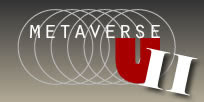Metaverse U '09 - All about the open virtual space
 This past weekend was the second iteration of Metaverse U put on by Henrik Bennetsen at Stanford University. The Metaverse U conference took place at Stanford University on May 29th and 30th. The goal of this years conference was to explore the cutting edge applications of virtual worlds and the open platforms that drive them.
This past weekend was the second iteration of Metaverse U put on by Henrik Bennetsen at Stanford University. The Metaverse U conference took place at Stanford University on May 29th and 30th. The goal of this years conference was to explore the cutting edge applications of virtual worlds and the open platforms that drive them.Henrik gathered an impressive lineup of speakers and I will embed their videos here once they go online. Some highlights from the presentations:
 Sirikata, Stanford's open source platform for virtual worlds, had a high representation this year with a demo that showed some of its editing features.
Sirikata, Stanford's open source platform for virtual worlds, had a high representation this year with a demo that showed some of its editing features.Jeffrey T. Schnapp (Stanford University) talked about cultural heritage with virtual worlds stating "museums are the original 3D world" and the need to embrace (inter)active models of educational programming with an emphasis on bottom-up counterparts to traditional top-down approaches.
John Hurliman (Intel) presented Cable Beach, a service based architecture for virtual worlds that defines protocols for communication between services and draft definitions of common services. It does not define policy decisions about what services to trust, intra-domain communication, and client-server protocol for 3D simulation. "Stop imprisoning identity and content."
Tom Murphy (ScienceSim) presented a collaboration of academic and commercial institutions externalizing their OpenSim servers and cooperating on the development of foundation tools and technologies to support science education in virtual worlds.
 Seung Wook Kim (Samsung R&D Center) represented the Virtual Worlds Roadmap and showed off the organizations new website.
Seung Wook Kim (Samsung R&D Center) represented the Virtual Worlds Roadmap and showed off the organizations new website.Remi Arnaud (Intel) co-author of COLLADA, spoke on the format as a COLLAborative Design Activity for establishing an open standard digital asset schema for interactive 3D applications.
Saki Bailey (The Kira Institute) is exploring the use of virtual worlds in developing new forms of research and education that are rooted in scientific and scholarly traditions, but are not confined by the usual disciplinary and academic boundaries. In the Kira workshops, professionals, amateurs, teachers, and students mingle freely together in the virtual world, creating a sort of emerging virtual public sphere.
 Vangelis Kokkevis (Google) presented on O3D, an open-source web (lower level) API for creating rich, interactive 3D applications in the browser.
Vangelis Kokkevis (Google) presented on O3D, an open-source web (lower level) API for creating rich, interactive 3D applications in the browser.Ryan McDougall (RealXtend) discussed the need for a truly open-source virtual world client viewer.
As impressive as the speakers were the attendees. Christopher Peri, no stranger to 3D web and mixed reality technologies was in the audience, Danny Maco with Exit Reality was present, as was real/digital home builder Greg Howes. I was happy to see 3D web veteran/game guru Dave Arendash also at the event. Maribeth Back (FX Pal) shared some amazing mixed reality work she is doing with Tcho's Chocolate factory (I will be posting about this soon).
Enjoy these videos I captured of the event.
Chris Platz - Stanford/Sirikata
Dave Arendash - IDEAbuilder
Eilif Trondsen - Virtual Worlds @ Work, SRIC-BI
Henrik Bennetsen - Stanford Humanities Lab
Maribeth Back - FXPAL
The event wrapped up the final hours as an un-conference where members of the audience suggested their own ideas for discussion groups. A great job done by Henrik and his team on another successful Metaverse U conference. Well done!
Comments